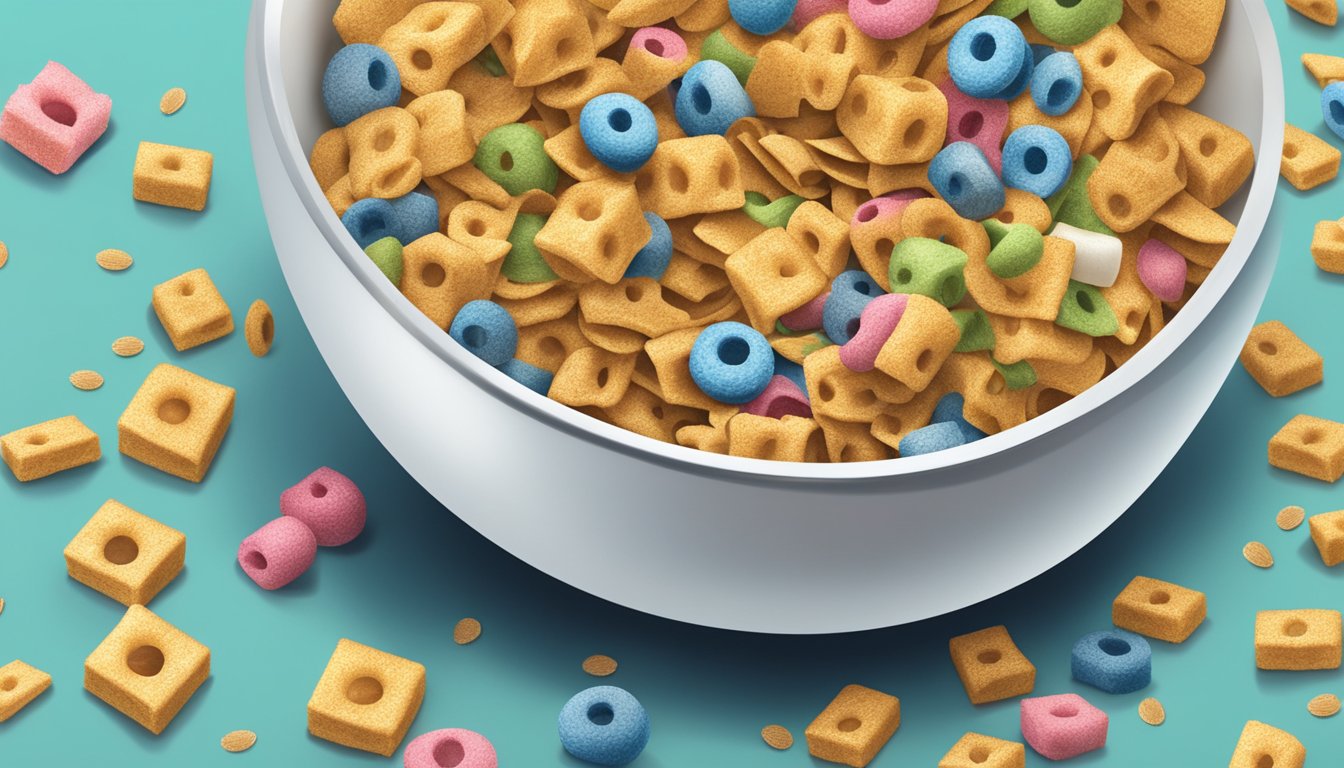Breakfast cereals can be a convenient way to boost your daily iron intake. Many popular cereals are fortified with this essential mineral, making them an easy option for those looking to increase their iron consumption.
Cereals with the highest iron content typically provide 90-100% of the daily value per serving, which equates to about 16-18 mg of iron. Some top contenders include Kellog’s Frosted Mini Wheats and Quaker Oatmeal Squares, both offering around 90-100% of the daily value for iron in a single serving.
When selecting an iron-rich cereal, it’s helpful to check the nutrition label. Look for iron or ferrous sulfate listed within the first few ingredients, as this indicates the cereal has been fortified with a substantial amount of iron. Whole grain cereals may also naturally contain some iron, though fortified options generally provide higher amounts.
The Importance of Iron in the Diet
Iron is an essential mineral crucial for many bodily functions. It plays a vital role in oxygen transport, energy production, and cognitive performance. Understanding iron’s importance can help guide dietary choices for optimal health.
Iron Intake and Recommended Daily Allowance
The recommended daily allowance (RDA) for iron varies by age and gender. Adult men need 8 mg per day, while women aged 19-50 require 18 mg daily. Pregnant women have higher needs at 27 mg daily.
Iron requirements increase during periods of growth and for women during pregnancy. Vegetarians and vegans may need 1.8 times more iron than meat-eaters due to lower absorption rates from plant sources.
Meeting these needs through diet is crucial. Good sources include lean meats, beans, fortified cereals, and leafy greens. Regular blood tests can help monitor iron levels and ensure adequate intake.
Iron Deficiency and Anemia
Iron deficiency is the most common nutritional deficiency worldwide. When severe, it leads to iron deficiency anemia, affecting millions globally.
Symptoms of iron deficiency include fatigue, weakness, pale skin, and shortness of breath. In children, it can impair cognitive development and growth.
Risk factors include:
- Heavy menstrual periods
- Pregnancy
- Vegetarian or vegan diets
- Certain medical conditions
Early detection and treatment are key. Increasing iron-rich foods and sometimes iron supplements can correct deficiencies. Regular check-ups help catch and address low iron levels before they become severe.
Benefits of Iron for Energy Levels and Cognitive Function
Iron plays a crucial role in energy production and brain function. It helps form hemoglobin, which carries oxygen to cells throughout the body.
Adequate iron levels contribute to:
- Improved physical performance
- Enhanced cognitive function
- Better mood regulation
- Increased attention span
Studies show that correcting iron deficiency can boost energy levels and cognitive performance in both children and adults. This highlights the importance of maintaining optimal iron status for overall well-being.
Heme vs. Non-Heme Iron
Iron in food exists in two forms: heme and non-heme. Understanding the difference can help optimize iron absorption from the diet.
Heme iron:
- Found in animal products
- More easily absorbed (15-35%)
- Sources: red meat, poultry, fish
Non-heme iron:
- Found in plant foods and fortified products
- Less readily absorbed (2-20%)
- Sources: beans, lentils, spinach, fortified cereals
To enhance non-heme iron absorption, pair iron-rich foods with vitamin C sources like citrus fruits or bell peppers. Avoid consuming calcium-rich foods or tea with iron-rich meals, as these can inhibit absorption.
Overview of Breakfast Cereals
Breakfast cereals offer a convenient and popular morning meal option. They come in various types, flavors, and nutritional profiles, with many fortified to provide essential vitamins and minerals.
Defining Fortified Cereals
Fortified cereals have added nutrients to enhance their nutritional value. Manufacturers enrich these cereals with vitamins and minerals not naturally present or found in small amounts. Iron is a common addition, making fortified cereals an excellent source for this essential mineral.
Many popular brands fortify their cereals with iron, B vitamins, and other nutrients. This process aims to address common nutritional deficiencies and promote overall health. Fortification levels can vary significantly between brands and types of cereal.
Comparing Nutritional Value of Popular Cereals
Cereals differ widely in their nutritional content. Some offer high amounts of fiber and protein, while others may be higher in sugar. Iron content also varies greatly among different brands and types.
Whole grain cereals generally provide more natural nutrients. Examples include:
- Bran flakes: High in fiber and often fortified with iron
- Oat-based cereals: Good source of fiber and sometimes fortified
- Rice cereals: Often heavily fortified with iron
Sugary cereals may have less nutritional value but are often fortified to improve their nutrient profile. It’s important to compare labels to find cereals that balance taste preferences with nutritional needs.
Understanding Nutrition Labels
Nutrition labels provide crucial information for comparing cereals’ nutritional value. Key areas to focus on include:
- Serving size: Ensures accurate comparisons between different cereals
- Iron content: Listed as a percentage of daily value (DV)
- Other nutrients: Fiber, protein, and added sugar content
Look for cereals that provide at least 20% of the daily value for iron per serving. This indicates a high iron content. Also, check for other essential nutrients like vitamin C, which can enhance iron absorption.
Pay attention to the ingredients list. Iron-fortified cereals often list “reduced iron” or “ferric orthophosphate” among the ingredients. This information helps identify cereals specifically fortified with iron.
Analyzing Iron Content in Breakfast Cereals
Iron content varies significantly among breakfast cereals. Fortified options provide higher amounts, while serving sizes and vitamin C play crucial roles in iron absorption.
Cereals High in Iron Content
Fortified Total: Whole Grain Cereal leads the pack with 18 milligrams of iron per cup, exceeding 100% of the recommended daily intake for adults. Other iron-rich cereals include Malt-O-Meal and Cream of Rice. Many popular cereals undergo fortification to boost their iron content.
Fortification involves adding vitamins and minerals not naturally present in high quantities. This process makes cereals a convenient way to increase iron intake. Consumers should check nutrition labels to identify cereals with at least 20% of the daily value for iron per serving.
Serving Sizes and Iron Quantity
Serving sizes impact the amount of iron consumed. A standard serving of cereal typically ranges from 3/4 to 1 cup. Iron content is usually listed as a percentage of the daily value on nutrition labels.
The U.S. Food and Drug Administration sets the recommended daily value for iron at 18 milligrams based on a 2,000-calorie diet. Cereals providing 3.6 milligrams or more of iron per serving are considered high in iron.
| Cereal Type | Serving Size | Iron Content |
|---|---|---|
| Fortified Total | 1 cup | 18 mg |
| Malt-O-Meal | 1 serving | 13.9 mg |
| Cream of Rice | 1/4 cup (dry) | High* |
*Exact amount not provided in search results
Role of Vitamin C in Iron Absorption
Vitamin C enhances iron absorption from cereals. Pairing iron-rich cereals with vitamin C sources can improve the body’s ability to utilize the iron consumed.
Good vitamin C sources to combine with breakfast cereals include:
- Fresh fruits (oranges, strawberries, kiwi)
- 100% fruit juices
- Bell peppers
This pairing is especially beneficial for those consuming non-heme iron from plant-based sources, which is less readily absorbed than heme iron from animal products.
Selecting the Right Cereal for Iron Intake
Choosing an iron-rich cereal involves considering fortification levels, sugar content, fiber, and other nutrients. These factors can impact iron absorption and overall nutritional value.
Impact of Sugar and Fiber on Iron Uptake
High sugar content in cereals can hinder iron absorption. Added sugars provide empty calories without nutritional benefits. Opt for cereals with less than 5 grams of sugar per serving.
Fiber, while beneficial for digestion, may interfere with iron uptake. Balance is key. Choose cereals with moderate fiber content, around 3-5 grams per serving.
Some high-fiber cereals are fortified with higher iron levels to compensate for reduced absorption. Reading labels carefully helps identify these options.
Considering Whole Grains and Other Nutrients
Whole grain cereals often contain more natural iron than refined varieties. They also provide essential B vitamins and minerals that support iron absorption.
Look for cereals listing whole grains as the first ingredient. Common whole grains include oats, wheat, and barley.
Pairing iron-rich cereals with vitamin C sources enhances absorption. Add berries or citrus fruits to your bowl.
Some cereals contain other nutrients that aid iron uptake, such as vitamin B12 and folate. These additions can boost the cereal’s overall nutritional value.
Assessment of Iron Fortification Levels
Iron fortification varies among cereals. Check the nutrition label for iron content, aiming for 15-20% of the daily value per serving.
Some brands offer 100% or more of the daily iron requirement. These can be beneficial for those with higher iron needs, like pregnant women or athletes.
Compare iron levels across different cereal brands. Total Whole Grain and Special K often rank high in iron content.
Be aware that excessive iron intake can be harmful. Consult a healthcare provider before choosing highly fortified cereals, especially for children or those with certain health conditions.
Comparative Analysis of Popular Iron-Rich Cereals
Several breakfast cereals stand out for their high iron content, providing an easy way to boost daily intake of this essential mineral. Each brand offers unique nutritional profiles and taste options to suit different preferences.
Profile of Cheerios Varieties
Cheerios, a household name in breakfast cereals, offers multiple iron-rich options. Original Cheerios contains 45% of the daily iron value per serving. Multi Grain Cheerios provides a slightly higher iron content, with 50% of the daily value.
Both varieties are made from whole grain oats, making them heart-healthy choices. Original Cheerios has a simpler ingredient list, while Multi Grain Cheerios incorporates additional grains like corn and rice.
These cereals are also fortified with other essential nutrients, including B vitamins and zinc. Their low sugar content makes them a healthier option compared to many sweetened cereals.
Nutritional Breakdown of Ralston Enriched Bran Flakes
Ralston Enriched Bran Flakes is a lesser-known but highly nutritious cereal option. It provides an impressive 60% of the daily iron value per serving, making it one of the highest iron-containing cereals available.
This cereal is made primarily from wheat bran and wheat flour. It’s rich in dietary fiber, promoting digestive health and satiety. Ralston Enriched Bran Flakes also offers significant amounts of other B vitamins and minerals.
Its relatively low sugar content and high nutrient density make it an excellent choice for those seeking to increase their iron intake through breakfast cereals.
Health Benefits of Weetabix and Multigrain Options
Weetabix, a popular British cereal, provides about 30% of the daily iron value per serving. It’s made from whole grain wheat and offers a good balance of nutrients, including fiber and B vitamins.
Multigrain options like Weetabix Protein or Weetabix Crispy Minis often contain additional iron sources. These varieties can provide up to 40% of the daily iron value per serving.
Weetabix cereals are known for their low sugar content and high fiber, promoting digestive health and sustained energy. Their versatility allows for various serving options, from cold milk to warm preparations.
Frosted Mini-Wheats and Iron Content
Frosted Mini-Wheats, including variations like Frosted Mini Spooners, offer a good balance of taste and nutrition. These cereals typically provide about 90% of the daily iron value per serving, making them one of the highest iron-containing options.
The cereal is made from whole grain wheat, providing substantial fiber content. The frosted coating adds sweetness, which may appeal to those who prefer flavored cereals.
Despite the added sugar, Frosted Mini-Wheats still maintain a relatively high nutrient density. They also offer significant amounts of other essential vitamins and minerals.
Examining Quaker Oatmeal Squares
Quaker Oatmeal Squares is another iron-rich cereal option, providing about 90% of the daily iron value per serving. This cereal is made primarily from whole grain oat flour and wheat flour.
It offers a good balance of macronutrients, with moderate protein content and healthy fats from added nuts in some varieties. The cereal is also rich in fiber, promoting digestive health and satiety.
Quaker Oatmeal Squares come in various flavors, allowing consumers to choose based on taste preferences while still benefiting from high iron content. Its crunchy texture makes it a popular choice for both breakfast and snacking.
Alternative Iron-Rich Foods

While breakfast cereals can be a convenient source of iron, many other foods provide this essential mineral. Incorporating a variety of iron-rich options into your diet ensures optimal nutrition and supports overall health.
Incorporating Legumes and Nuts in Your Breakfast
Legumes and nuts offer excellent iron content alongside other vital nutrients. Lentils, chickpeas, and black beans can be easily added to breakfast bowls or savory morning meals.
A half-cup serving of cooked lentils provides about 3.3 mg of iron. Nuts like almonds, cashews, and pistachios are also iron-rich snack options.
Try spreading almond butter on whole-grain toast or sprinkling chopped nuts over yogurt for a nutritious start to your day.
Benefiting from Leafy Greens and Whole Grains
Leafy greens and whole grains are powerhouses of iron and other essential nutrients. Spinach, kale, and Swiss chard are particularly high in iron.
A cup of cooked spinach contains approximately 6.4 mg of iron. Quinoa, oats, and brown rice are iron-rich whole grains that can form the base of a hearty breakfast.
Consider adding sautéed spinach to your morning omelet or preparing overnight oats with a mix of iron-fortified cereals and fresh berries.
Understanding the Role of Cereals in a Balanced Diet
While cereals can contribute significantly to iron intake, they should be part of a varied diet. Many breakfast cereals are fortified with iron, making them a convenient option.
Some cereals provide up to 100% of the daily recommended iron intake per serving. However, it’s crucial to read labels and choose cereals with minimal added sugars.
Pair iron-fortified cereals with vitamin C-rich fruits like oranges or strawberries to enhance iron absorption. Remember that a balanced diet including various iron sources supports optimal oxygen transport and overall health.




